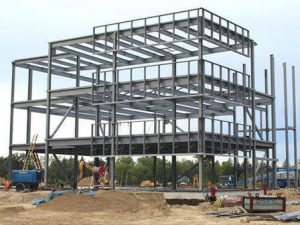Steel Structure Housing: A New Roadmap for India’s ‘Housing for All’
Promoting steel structure-based construction will be a significant step in realising the Goal 11 of the Sustainable Development Goals (SDGs) – Make Cities and Human Settlements Inclusive, Safe, Resilient and Sustainable

“Housing for All by 2022’ has been one of the key declared objectives of the Indian government since 2015. Although ‘Housing’ is a basic human right, it still continues to be a distant dream for millions of people in India. Moreover, it is largely presented as one of the biggest employment-generating sectors of the country’s economy by providing livelihood to many in the construction industry, cement, steel, timber, and other industries and establishments directly or indirectly related to the housing and commercial construction sector. Selection of various structural materials for construction of both commercial and residential buildings is a challenging task with the coming of wide array of materials, along with the traditional concrete-based solutions. While climate-and eco-friendly, including mud house, solutions are currently in vogue for residential houses, using steel structure for the same is neither widely discussed nor encouraged enough.
Dilapidated Buildings: The Death Trap
It is estimated that poor construction standards and dilapidated buildings kill about 2000 people per year in India. Metros like Mumbai and Delhi are known for both residential and commercial building collapses leaving many dead every year. In August 2017, three different buildings collapsed in Mumbai’s Bhendi Bazaar area killing 34, and its neighbouring city Thane witnessed one of its worst accidents in 2013 when an under-construction building collapsed killing more than 70 people. In November 2010, at least 67 people were killed and 73 were injured in the Lalita Park building collapse in Delhi. Lalita Park housed about 200 people, mostly poor migrant families and small businesses. In September 2014, an 11-storey under-construction building collapsed in Moulivakkam, about 20 km from Chennai, killing at least 61 people. Delhi, Bengaluru, Chennai, Kolkata and other major cities are not exceptions to building collapse and related fatalities.
Also Read : Human Rights Experts Urge For Make In India And Skill India Responsibly
As per the National Crime Records Bureau’s (NCRB) ‘Accidental Deaths & Suicides in India’ (ADSI) data, 38,363 people lost their lives due to the collapse of various types of structures in 37,514 incidents between 2001 and 2015.
NCRB records say that a total of 1885 people lost their lives due to collapse of structures in 2015. Although there has been considerable variation in terms of the number of incidents of structure collapse over the last 15 years or so, the highest number of such incidents occurred in 2011 when 3125 structures collapsed. There were more than 3000 such incidents each in 2008, 2011 and 2013, which somehow came down to less than 2000 in both 2014 and 2015. While these are the only two years when the number of incidents was less than 2000, there were seven incidents of structure collapses per day between 2001 and 2015. If we look at the number of fatalities, there were more than 3000 deaths in both 2001 and 2011. However, except these years, the death toll was more than 2000 during the 11 other years. The death toll was less than 2000 in both 2014 and 2015 may be because of the lesser number of building collapse incidents during the period.

NCRB categorises the data on collapse of structures into five categories such as collapse of residential and commercial buildings, dams and bridges, and other structures like flyovers, etc. One of the significant observations from the NCRB data is that 40 per cent (15000) of the total fatalities resulted from the collapse of residential buildings between the years 2001 and 2015. A total of 3981 people lost their lives because of the collapse of commercial buildings, which was 10 per cent of the total death toll. Collapse of dams and bridges together accounted for about 4 per cent of all the fatalities, while the remaining 45 per cent of the deaths were due to the collapse of other structures like flyovers, etc.
The presence of hundreds of dilapidated buildings, especially in cities, across the country is a matter of concern, as they remain as death traps. As per government data, Mumbai alone has 700 such structures. Further, it needs mentioning that 0.67 per cent (DISE survey of 2016—17) of the school buildings in India too are in a dilapidated condition, which calls for attention on a priority basis.
Earthquakes and other Natural Calamities
Many regions in India are prone to natural calamities including floods and earthquakes. Structural collapse of building is one of the major causes for rising death tolls during earthquakes. A study by Cobum, Spence and Pomonis in 1992, based on the worldwide database of 1100 earthquakes, has found that structural collapse accounts for 95 per cent of deaths during earthquakes. In cities with rapidly expanding population and with habitations with higher person per building, earthquakes will result in greater fatalities.
Also Read : Technology As An Enabler Artificial Intelligence For Accessibility
Single or multistoried reinforced concrete frame structures add to the vulnerability of the buildings during earthquakes.
Fall of heavy objects made of concrete and getting trapped in the debris are the main reasons for the fatalities. Steel structural buildings, due to their specific features discussed below, are immune to higher risks during earthquakes and natural calamities to a greater extent.
Using steel, including light-weight steel frames, in construction, especially residential buildings, thus gets significance. In commercial constructions, Pre-Engineered Building (PEB), which is a versatile building system fabricated internally and erected at a different location, has become fashionable in metros and even in some small towns across India, the use of steel in residential buildings and small houses is yet to gain momentum. PEB systems are extensively used for industrial and commercial constructions. With minimum maintenance and superior strength, PEB is used for warehouses, factories, workshops, showrooms, offices, parking sheds, etc. Steel-structure based houses and villas and even resorts, which are robust, durable and elegant, are designed and constructed by companies, but not on a large scale because of various reasons.
